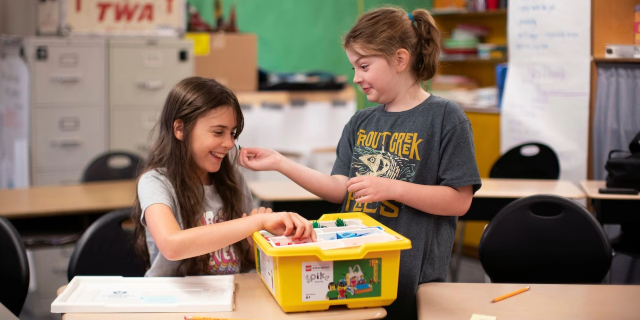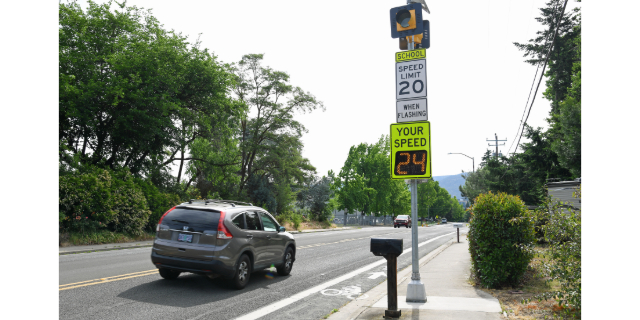Dozens of schools, districts pass up summer learning money, citing tight timeline
Published 8:50 am Wednesday, June 4, 2025

- Back in the summer of 2023, rising fourth graders Odette Light, left, and Olive Gawron participated in a math exercise involving Legos at Stephenson Elementary School in Southwest Portland. Portland Public Schools is planning a summer learning program this summer, but was not eligible for a cut of $35 million in state grants. (Beth Nakamura/The Oregonian)
Others, like Portland, weren’t ever eligible
Gov. Tina Kotek recently hailed the signing of a bill that set aside $35 million for summer learning programs this year and next as the “biggest bill” of the legislative session thus far, calling it “a huge win for all of Oregon.”
But for the 74 school districts, charter schools and education service districts that so far have informed that state that they were turning down their cut of that money, that win came too late and with too many strings attached.
The Three Rivers School District in Josephine County is a case in point. The 4,300-student district was eligible to receive $654,000 in summer school funding, money that was intended to help lagging students learn to read and write at grade level, with outcomes to be tracked and reported back to the state. Programs are to last for at least 80 hours, with consistent student attendance required.
At Three Rivers, only 34% of third-grade students read at grade level, according to spring 2024 state test scores, below even the state average of 39%.
But the district declined the money.
“Given how late it came, we just wouldn’t have time to assemble a meaningful program for our students,” Superintendent Dave Valenzuela said.
Among those who also turned down the grant: All eight of the school districts and charter schools that were ranked at the very top of the state’s list of who most needed the money, based on the share of their students who scored proficient in reading. Most were rural and tiny school districts and charter schools, but the top eight also included the Reynolds School District-sponsored HOLLA charter school, where 100% of students are nonwhite, and Harmony Academy, a recovery high school sponsored by the Lake Oswego School District.
Education researchers have found that well-designed summer learning programs, along with regular, intensive tutoring sessions, are one of the most effective ways to help students who are behind catch up.
The $35 million is not enough for every school district, regional educational organization, tribal learning center and charter school in the state to receive funding. So, as it did last year, the Oregon Department of Education prioritized certain schools and districts to the funds. The state used a formula based on literacy proficiency rates, including among demographically diverse groups of students. The smallest grants awarded this year are $20,000 and the largest are $1,000,000.
The money that some districts passed up won’t go to waste; it will just go to other schools and districts further down the original priority list.
Still, several of the state’s biggest districts didn’t make the cut to receive funding or even be placed on the waitlist for funds to open up, including Portland Public Schools and the Beaverton, Eugene and Bend school districts. That does not mean that those districts will not offer summer learning programs, just that they will have to find more of the funding for it from a separate source.
Hillsboro, Salem- Keizer, North Clackamas, Gresham-Barlow, David Douglas and the Reynolds school districts all did make the cut, accepted the funds and got the maximum grants of $1,000,000 apiece.
Oregon Department of Education Director Charlene Williams said in a message to schools that the state is planning to “take a deeper dive” into its summer learning funding formula, to examine and perhaps update how it arrives at its eligibility conclusions for future summers.
Kotek and school advocates had urged lawmakers to move more quickly on approving summer learning funds, given that it typically takes months for districts and charter schools to put together staffing plans, partner with community groups to offer enrichment programs to round out the school day, notify families about summer options and make sure that they are designing programs that meet state guidelines.
But lawmakers did not sign off on summer learning packages until mid-April, and applications from school districts and charter schools did open until the end of that month and were due just two weeks later, on May 12.
It all came too late for the Redmond School District, in Central Oregon, which turned down the proffered $1 million allocation.
“The release of these funds so close to the end of the school year provides limited time to develop and implement a viable and executable plan that meets the requirements of the grant,” Linda Seeberg, the district’s assistant superintendent of teaching and learning, wrote to the Oregon Department of Education regarding the grant and later shared her feedback with The Oregonian/OregonLive. “One of the big barriers we have experienced in the past is finding staff who are interested/available to apply for summer learning positions.”
It’s not the first time that a lagging timeline has thrown a wrench into summer learning plans. In 2024, lawmakers earmarked $30 million for summer school programming, but did not do so until March. A wrap-up report by the Oregon Department of Education about 2024’s programming later suggested that the tight turnaround between the confirmed level of state funding and the start of summer led to “inconsistencies” in how student learning goals were set and measured at districts that received the money.
Summer 2026 could go more smoothly, because lawmakers have pre-approved funding, meaning that distribution of the money can start far earlier. Seeberg says Redmond plans to apply for that round.
Legislation approved this year also set aside $12 million to seed summer learning programs in June of 2027; it will be up to a future legislative body to continue the funding past then.
The large number of districts declining their grant allocations has opened the door for some districts that were closer to the bottom of the eligibility list to get some funding. The Tigard-Tualatin School District, for example, will receive $567,000, despite being 161st in line on a list of nearly 300 schools and districts.
“Due to budget pressures, Tigard- Tualatin would not have been able to offer this summer learning instruction without the added state funding,” said Alex Pulaski, a spokesperson for the school district, who said the money will support targeted reading and math interventions for elementary school students. “This opportunity was too good to pass up, despite the short timeline for applying.”






